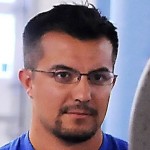
By Carl Valle
For years, Coach Andersson puts together an awesome seminar that is my favorite educational resource. I have attended three of them personally, and if you are an American coach in professional sports or elite sprinting, you simply need to go to Sweden in July. I have been part of many conferences and clinics by providing suggestions to speakers, such as the Boston Sports Medicine and Performance Group and other conferences. Usually what happens in America is that the presenter or noted authority attending WindSprint will eventually speak at some of the leading conferences 4-5 years later. Located in Sundsvall, the conference is held the day before the track and field meeting, and it’s a pleasant place to visit. This year I spoke on plyometrics, but the stars of the show were some of the leading authorities in sport science. The strength of a good conference is the attendees, and many successful coaches in attendance could be up on the podium as well. I was busy in Milan doing business and attending a track meeting the week before, and visited Karlstad for the Folksam Grand Prix during the trip, home of Olympic Gold Medalist Stefan Holm.
Travel to Sundsvall Sweden

If you want to attend the Windsprint Seminar, I suggest going flying into Arlanda outside Stockholm and take the express train to Central Station if you want to take a train into Sundsvall, or fly into a sister airport and fly SAS directly to Sundavall. The newer high-speed trains offer free Wi-Fi and power, making the 3-4 hour trip feasible if you are catching up on work. For anyone who has seen Wings, the airport is that small, but the flights are inexpensive.
Staying in Sundsvall is awesome since everything is close and enough shopping and restaurants exist to provide options without being too far to walk. A wise suggestion is to stay at the Elite Hotel, and remember in Sweden breakfast is free and many times a highlight. If you are a thrower or former football player be warned, the meal sizes are smaller so you will either need to have more trips to the buffet or embrace the healthy dietary change. The lox is so good, even if you don’t like fish you will be converted or at least tempted.
Juha Ruohonen CHECK, Finland
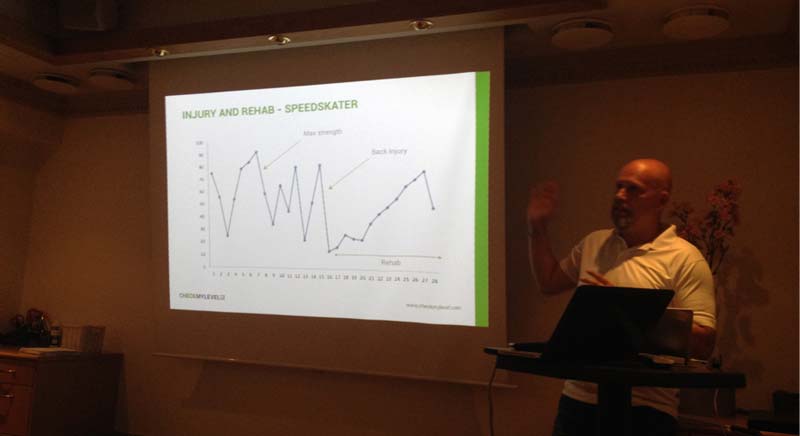
Usually I don’t like attending conferences in the US that promote a product, but in Europe it’s far more professional and not like an infomercial. I have used the system for a while with a handful of people, along with other coaches. Juha explained the origin of the system, and it was interesting to see how old the science and technology were, giving me a little comfort that I could look at the clinical research. Like most sports monitoring solutions, many useful tools originate from Horses in Finland. Interesting many of the best diagnostic software for sports medicine comes from equine sports, and some consultants own the filters and use them for athletes currently.
Heart Rate Variability (HRV) is an excellent marker for overall health, but it was great to see a comparison between data of HRV and fatigue metrics of their system. At times, the HRV was parallel to their scores, and sometimes the data seemed to lag or be polar opposite. What was perhaps the best presentation on sharing data I have seen in years was the timelines shared with real athletes. Every slide that he presented was textbook in how companies should engage their users. Not sharing data is a sign of selling vaporware, meaning either the product doesn’t work or nobody uses it. Time after time, a firestorm is created (sometimes a coverup) when a coach or company is asked to see data. If one is using a monitoring device for a season, show us the data! Juha showed an array of professional athletes and explained the simple metrics and how their season went. Injury was the most obvious sign of readiness drop, and it was awesome to see how rehabilitation was visualized with the data. The chart showed what happens if one returns a little too quickly from rehabilitation with a crash immediately after resuming competition. Perhaps some simple algorithm can calculate readiness based on how long one has reached stabilization enough to get back on the field. Without quantification, it will be an educated guess, but perhaps the use of a good monitoring system can help make the decision more precise.
I suggest trying out the device with a few compliant athletes, even if they are not world champions or professionals. After about 90 days, start looking at the data and let the line plot tell stories and see if anything matches the workout data. The device works with a smartphone via Bluetooth connection, and has a strip that sends out current to excite the nervous system, thus evaluating general readiness of the body for explosive action. Going head to head with Omegawave CNS monitoring, I would like to see someone testing daily, along with a profile of mood states and training data. Overall the presentation was excellent and I will give the system another run to see what I can get from it.
Carl Valle, Boston, United States
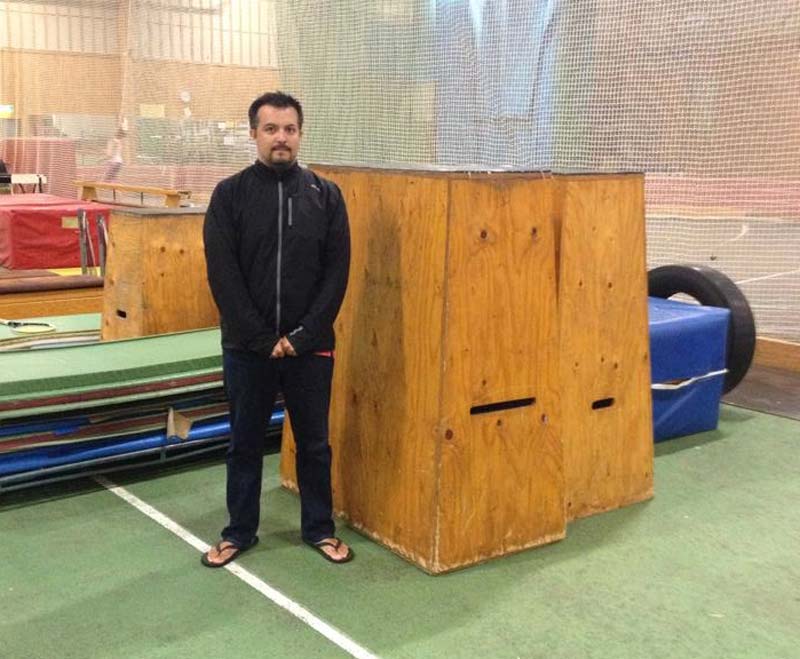
The above photo was taken at the Karlstad Indoor Facility before the meet. What was fascinating about the facility was all of the equipment and design, showing what different countries find valuable. Don’t worry, no 155 cm box jumps before the finals!
My presentation ran on time and included an array of slides showing velocity models to make a point. Whatever one does, it needs to show up somewhere or you may want to rethink things. Jump training, is used for purposes of improving performance in sprinting speed, be it max velocity or acceleration. I went over the typical research but focused on drilling down to the anatomical and neurophysiology side of plyometrics. I came up with a theoretical area of how a plyometric program may help 100m athletes, and from the feedback of several attendees it was well received. In the audience was Pierre Jean Vazel, one of my favorite expert coaches who is someone everyone should spend time with. His historical knowledge and training philosophy is perhaps the most extensive of all experts. Reading the Freelap USA articles provides enough of the content in the presentation.
Some take home points were not earth shattering, but one of the areas we need to do better is taking exercises and seeing the details of each one and carefully place them into workouts. Injuries are real, and I think many athletes simply overload areas because strain is hard to quantify on tendons, cartilage, and bones. Unlike running where distance, speed, and perhaps resistance can be easily adjusted and quantified, plyometrics are a little murky.
- Use a contact mat and get contact time and flight time at least if doing depth jumps. In addition to the actual kinetics, kinematic data should be captured with a camera. It’s more work but if it reduces injury or strain, it could salvage a season. Like I mentioned earlier in the Top Five Plyometric Exercises for Speed, depth jumps are good screening tools and excessive delay in contact time means possible dorsiflexion and pronation issues.
- Morphological adaptations are unknown and very little information is available about the long term changes to tissues from plyometrics compared to sprinting and lifting only. Some of the Robert Newton discussions hint to the differences between maximal strength and plyometrics on the tendons, but I have not seen anything concrete here and hypertrophy of a tendon or remodeling for greater stiffness isn’t available.
- Many less talented athletes try to break through plateaus or force adaptations with intense plyometrics. This backfires three times in my opinion. First, spending resources of energy to non specific areas means the most obvious ways to get faster, sprinting, are compromised. Second, elite sprinters may not be that much more talented but perhaps being early developers those that are not as fast choose to do plyometrics to “catch up”. If this was the case, the lane 1 and land 8 guys in the Diamond League “hop” onto a plyometric program and start running 9.7s and 9.8s. Development stagnates with injuries, and the extreme “get fast quick” tends to slow down improvement rates.
- The goal of plyometrics is to support foot strike for faster sprinting. Some athletes historically have run very fast with plyometrics as a major part of their training, but on average, running based programs seem to be the most successful. I think the proposed idea of doing as much as necessary and not as much as possible works here.
I don’t think plyometrics are essential, but they are complimentary if done perfectly. If one is going to do plyometrics the composition in a program is going to be not much more than 20% of the resources. Some programs have done insane routines and everyone gravitates to them because the 6 foot depth jumps stand out. I think if one removed the intense jumping and added something more conservative, the results would be there and the shelf life or career longevity would enable athletes to be successful out of college.
Stefan Sandlund, Umeå Universitet
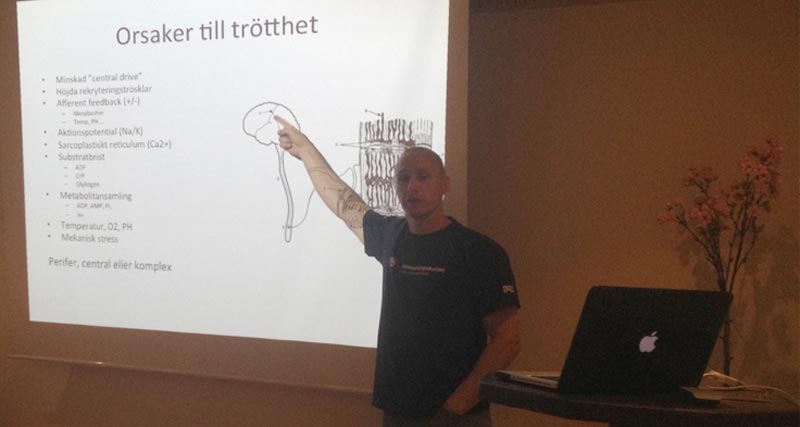
Stefan’s presentation was in Swedish, so I wasn’t able to get all of the information provided. Fortunately anyone who reads Swedish and is a follower of Scandinavian training information will find the slides easy to follow, especially that the charts and graphs were from research. Stefan was heavy into the physiology and knew his stuff about muscle biopsy. I think that Stefan’s presentation would be crucial to coaches looking into the long term adaptations of training. For over an hour, Stefan dug deep, really deep, to the cellar responses and created a roadmap for coaches to follow along to what happens to the body to chronic loading. Here are some random thoughts about why his presentation is important to team performance specialists and sprint coaches.
- Review your sport science each year, even if it gets old. Too many coaches forget elementary physiology and while science is not a beacon of light, we need to have rules based on foundational science.
- Science used to defend a position is fine, but motives of why one is sharing research are important. Several coaches and even some sport scientists have a personal agenda and that becomes biased.
- Many reasons why athletes perform poorly or get injured can be rooted to simple muscle fiber composition and even individual enzyme levels. Coaches need to move away from vague energy system training nonsense and think about how chronic loading is making either temporary changes or morphological adaptations.
- Physiology loses its value when it becomes the focus of performance. This was not stated in the presentation, but adaptation theory should be supporting ideas of training methodology.
My fear is that currently we are moving towards a pop science direction with sport and need to be grounded in the less excited research and do our homework better. Every time I hear a presentation like Stefan’s is a good reboot to the necessary education of physiology. It would be popular to post the charts and summary tables, but I think a smarter choice would be to read the studies on current performance physiology and review yearly programs to see what is likely to be augmented by training.
Mehis Viru, University of Tartu, Estonia
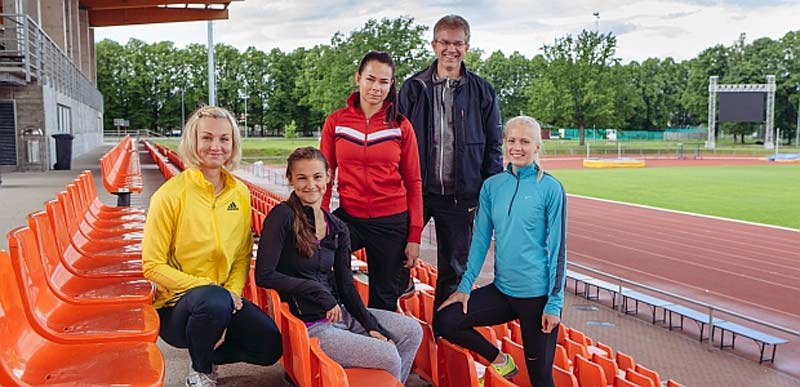
One of the people I wanted to meet was Mehis Viru, a sport scientist, author, and athletics coach. He and his father wrote the book Biochemical Monitoring of Sport, a bible of understanding adaptation from the cellular perspective. It’s been more than a decade since the publication, and some of the science have evolved and Mehis was honest about that during his presentation, but the principles are timeless. I liked the presentation and it appeared to have three distinct parts.
The first part was adaptation models, specifically how the entire body improves. Viru touched briefly on hormones obviously, but he was superb about getting to the core area of super compensation models. I think the book written by Virus was a good outline, but the value of meeting and listening so someone is priceless. For example cortisol’s reputation is often misinterpreted as something evil, but in reality interpretation is needed to appreciate what is going on. Mehis explained the difference between an acute response of hormones and the long-term adaptation of the endocrine system perfectly.
The second was some holistic reflections that connected the sport science to something more tangible. I liked the chart of Gerd Kanter’s performance chart to show each year’s progression and the recent regression. It would be nice to have blood panels of Gerd over each phase of training to see what was going on inside, as the technical part of the discus is important but the endocrine system supports practice loads.What was funny and important was the quote about Irina Primalova’s coach bashing Vekhoshansky and Matveyev, and it brought up an important problem about theory versus reality.
Finally, the last part of the presentation was application of training. What you do before, during, and after training. At first glance, the information seemed typical, but Mehis explained how the devil is in the details and I loved the point about priming the mental side of sport. What is going to be an issue I think is how team sport uses video to prepare for their opponents given the information that sport science is sharing. Positive or negative feedback as well as internal versus competition video will make watching film more than just strategy and tactics, but a chance to periodize an athlete’s physiology.
Adaptation and improvement are similar but not the same. If an athlete improves from being leaner, that is a passive change but not adaptation. Many things in training can improve performance without adaptation. Adaptation is improvement from the right amount of stimulus. Taken from the abstract of the article Evaluation of Endocrine Activities and Hormonal Metabolic Control in Training and Overtraining, the paragraph really touches to the cornerstone of training.
“An essential task of hormones in metabolic control is to interference into cellular autoregulation and to ensure an extensive mobilization of resources of the body. Otherwise the actualization of potential capacities of the body is impossible. Accordingly, the exercise performance depends on influence of hormones on metabolic processes. Therefore, the magnitudes of hormonal responses in exercises, including competition performance, as well as their interrelations, allow us to understand the actual mobilization of various metabolic resources. However, in monitoring of training the significance of hormonal studies is not limited only by this approach. The determination of hormones can provide information on the adaptation to certain levels of exercise intensity and duration, as well as on disorders of adaptation, including exhaustion of the organism’s adaptivity and overtraining phenomena. Hormonal responses can be used for assessment of the trainable effect of exercise session and for control of the recovery period. In order to get actually information and to avoid misunderstandings and wrong depiction, several cautions and limitations must be taken into the consideration.” — M. Viru and A. Viru 1999
As blood analysis grows, we will start to see better indicators of adaptation and adaptability with athletes. Sure, training workouts will share the strain prescribed, and the response of improvement will share the outcomes. Unfortunately if training was so easy, everyone would get amazing results all the time. Listening to Mehis speak on Friday in person, his coaching and athletic background was very helpful in ensuring applied sport science was shared, not esoteric information. He and others share the belief that science can help coaches raise the potential of athletes, and we have a lot to learn.
Seminar Wrap Up and Final Thoughts
The beauty of small seminars is not just the ability to ask questions and talk to other attendees, it’s about working collaboratively to improve the sport. Most small seminars are not designed to network for jobs or create leads for the speakers, but they are motivated by the purity of education. Anyone wanting to do a tour of track and field in Europe and wish to learn should head to Sundsvall and watch one of the best meets in action and learn from some great people in performance.
Please share this article so others may benefit.
[mashshare]

